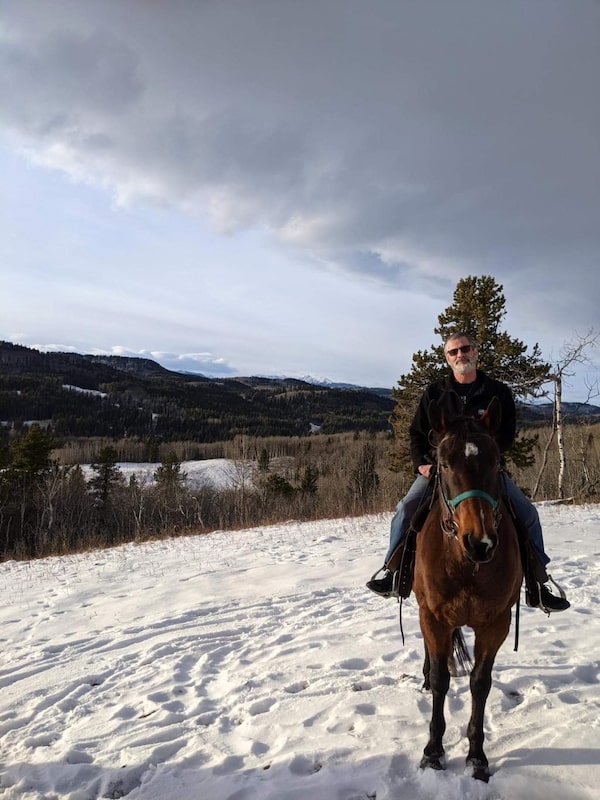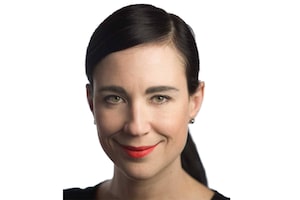David Milgaard, who was wrongfully convicted of murder, finds peace at home in Cochrane, Alta., May 22, 2019.Todd Korol/The Globe and Mail
I was sitting in a crowded little bar in Moose Jaw last week. It was late on Friday night, an almost-too-stereotypically Canadian prairie scene. Glasses of beer glistened amber on the tables around us, hockey players gliding by in endless loops on the TVs above. A rowdy crew of country boys filled the room with their laughter and noise. Outside, the Saskatchewan sky lifted dark and vast.
I was with family, feeling happy and joyful after two years apart, when through the ruckus of the bar, I caught the mournful voice of the late Gord Downie. Twenty years for nothing, well that’s nothing new, he sang. Besides no one’s interested in something you didn’t do. A Canadian icon, singing about a Canadian tragedy: The wrongful conviction of David Milgaard. For a moment, our conversation turned sombre, as talk always seems to when David’s story comes up.
“It’s terrible what happened to him,” my aunt said, shaking her head.
In the past few years, I had been in contact with David often, and he’d messaged me just the evening before. Two days later, on that same trip, I would get the shocking news that he’d fallen suddenly and gravely ill. He died on Sunday, May 15, at the age of 69.
Word of his death reverberated across the country, deeply upsetting those who knew him personally, and also many who didn’t. David had been arrested, charged, and wrongfully convicted for the murder of Saskatoon nursing assistant Gail Miller in 1969, and the fight for his release, exoneration and compensation – and the eventual inquiry into his case – spanned four decades. David’s story had gone on so long, and was so far-reaching, that for many Canadians – and maybe especially those of us on the prairies – it felt like he was always there, his life’s struggle continuing in the background of our own lives. Like Wheat Kings, the song about his life, playing amid the bustle of a crowded bar.
I had an additional connection. My parents bought my early childhood home from David’s parents, when they moved closer to the penitentiary in Stony Mountain after his conviction. Through the years, I used to think about that fleeting overlap between our two families, the memories and moments held within the walls of a small white bungalow.

There are other wrongfully convicted people in Canada, but David is arguably the most well-known.Courtesy of David Milgaard
I met David after being asked to host an event with him at the Canadian Museum For Human Rights in Winnipeg in the spring of 2019. The 50th anniversary of his arrest was approaching, and after the event, I asked David if he would let me write a profile of him. I thought it would be an interesting time to reflect on his life and show people how he was doing.
I’d seen firsthand what a profound effect David and his story still had. I felt it myself, and I could see it clearly in others. From the stage, I watched people in the audience brushing away tears as he spoke. Afterward, a throng of attendees crowded around to thank him, to tell him how much he and his mother had inspired them, how they had always believed in his innocence. Among them was Brian Anderson and his family, who have been working to overturn Mr. Anderson’s own 1973 murder conviction.
David told me he would have to think about whether he wanted to do an interview. He didn’t particularly like the attention, and he wasn’t sure if he wanted to put himself out there again. A few days after the panel, he called and said I could come to his home outside Calgary.
I pulled up to David’s townhouse in Cochrane on an overcast spring morning. It was exactly three years ago. May 21, 2019.
David was waiting for me at the front window. I had seen his face so much in the news that it was deeply familiar, like I knew him before he even opened the door.
His place was simple and modest. By then he had separated from his wife, Cristina, and there was just enough space for himself and his children, Robert and Julia, then 13 and 11. He had long ago lost all the money he received in compensation, some spent on himself and his travels, but most given away, poorly invested or grifted by people who took advantage of him.
I could see how easily that happened. For someone who had survived so much, there remained an obvious vulnerability to David. He had been a boy when he was arrested and plucked out of the regular world, a man when he returned to it. He had lost out on so much. Coming out of prison was an experience he often likened to being released onto the moon.
There are other wrongfully convicted people in Canada, but David is arguably the most well-known. That is owing in no small part to his mother, Joyce, who made them both so public, pushing her son’s story in front of every journalist, every politician, every Canadian so persistently that no one could look away even if they wanted to.
But there was also something about David himself that connected deeply with people. I sometimes wondered if it was the sheer magnitude of injustice that touched people so profoundly, the very idea of an innocent man spending 23 years in prison for such a hideous murder. Or if maybe it came from a feeling of collective guilt, because so many people saw he was innocent long before it was proven with DNA.
Or maybe it was because, even though he walked out of Stony Mountain 30 years ago, it was clear David Milgaard would never truly be free.
His early years outside prison were difficult, and the country watched as he stumbled. But even later, once he had given up drinking and found some stability, there remained a palpable sorrow.
I remember all the notes around his house, reminders of the things he was trying to do, the way he was trying to be. A page of “challenges” sat on the kitchen table. Third on the list was “taking care of myself.”
I spent two days with David. We talked, delivered lunches to his kids at school, walked along the train tracks near his house. Agreeing to speak with me was an act of trust and courage. David’s life and case had been documented extensively over the previous 50 years, sometimes well, other times poorly and inaccurately.
When the story came out, David called to say how touched he was that people still cared.
After that interview, David and I spoke and messaged regularly. When Joyce died in March, 2020, I wrote her obituary for The Globe. Sometimes David sent me humorous videos, or music he was listening to: Tim McGraw’s Humble and Kind and a version of Bob Dylan’s I Shall Be Released. He often sent me photographs of himself. In one, he is riding a horse in the snow, with mountains in the background and dark clouds sweeping overhead. In others, he is dressed up in a suit for a webinar, going out for a walk, showing off his beard to get my opinion on it.
But the thing he most wanted to talk about, always, was the creation of an Independent Review Board to examine potential wrongful convictions in Canada. He believed deeply in the importance of this, and over the time I knew him, grew increasingly frustrated that, despite positive signs here and there, it still hadn’t happened.
In the past two years, he had also been very focused on the case of Odelia and Nerissa Quewezance, two Saskatchewan sisters who have served almost 30 years for a murder their cousin confessed to committing. David advocated both publicly and privately for their freedom.
“WHEN is your story coming out,” he wrote to me, more than once, when I was working on a feature about the sisters’ case. The idea of any wrongfully convicted people being in prison was excruciating to him. He insisted that the sisters needed to be released “NOW.”
He was passionate about these causes – relentless, even, a trait he undoubtedly learned from his mother and tried to emulate. But it was not easy for him. Even after decades outside prison, after all those multitudes of speeches and interviews and events, it was deeply painful for David to talk about those parts of his life. I could see how hard he worked not to let his anger overwhelm him.
During our interview in 2019, David told me he kept doing public appearances because he needed the money he got from them, but also because he felt obligated to do whatever he could for other wrongfully convicted people.
“How could I not help?” he asked me. His eyes searched mine for an answer.
He told me that, at almost every second public event, a mother would come forward and say that their son or daughter had been wrongfully convicted, and plead for his assistance.
“And that’s really tough,” he said. “Because they don’t seem to realize that, you know, David Milgaard is just a human being. That there isn’t really much that I can do to help their son or their daughter in the situation that they’re in.”
Perhaps that’s another part of what connected so deeply with people. How, even after everything he had been through, he kept wanting to make things right.
But where his mother had appeared tireless, it was obvious to me David was tired. In April, he sent me a news story about his plans to end advocacy work. I told him I was glad he was able to make that choice, if it felt right for him and his children.
“I do it because I feel I can’t walk away from doing it,” he’d told a reporter with the Saskatoon Star Phoenix. They were speaking on the 30th anniversary of his release from prison. “And at the same time, I feel I need to walk away from doing it because I really have to give what’s left of my life to my family.”
He died exactly four weeks later.
I found out about his death as I was preparing to check out of my hotel room in Moose Jaw on Sunday. The news left me stunned. It seemed far too soon, so unfair and unjust an ending after everything he’d been through. As one of my friends said, “One would have thought he should live to at least 100 to make up for lost time.”
The final message David sent me was about Odelia and Nerissa Quewezance, and the continuing work to have them released from their life sentences. Before that, he’d sent a picture of himself. In it, he wore a grey and white toque and a short, scruffy beard. He was sitting in a car. I don’t know where he was going, but he had a slight smile. And he looked happy.
 Jana G. Pruden
Jana G. Pruden